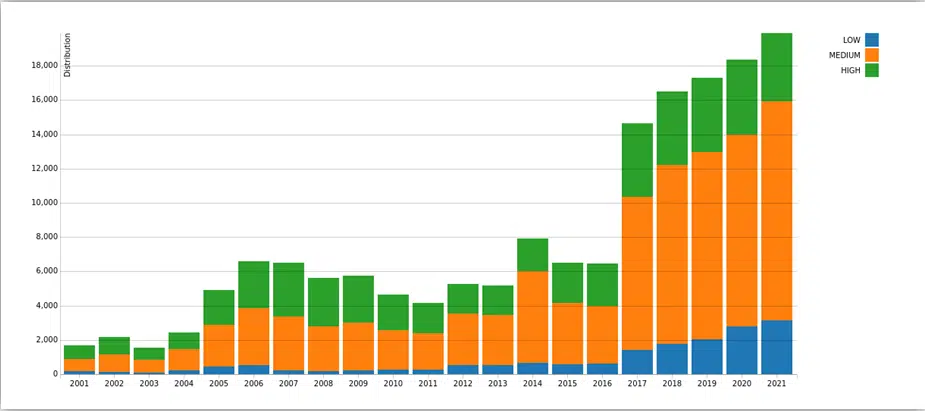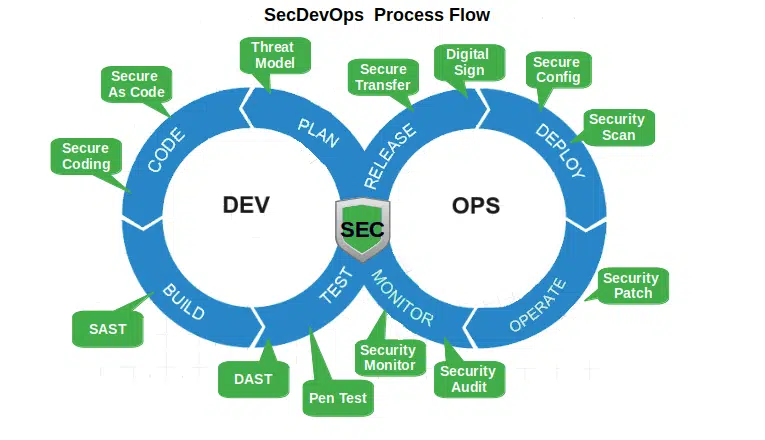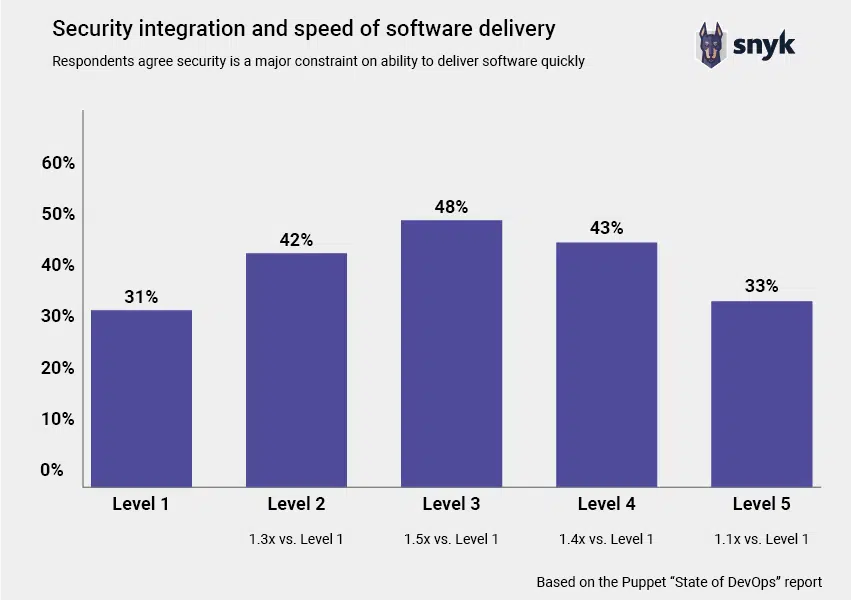What Is Secure DevOps? SecDevOps Explained

Learn how integrating secure devops into your business strategy can improve your software, protect your organization, and put security at the heart of software development without having to choose between security, speed and innovation
2021 was another rough year for cybersecurity. With hacking and ransomware making the headlines throughout the year, the number of data breaches in the U.S. by Q3 2021 exceeded the total number of those detected in 2020. Now in 2022, businesses are continuing to face challenges at every turn as they try to protect their data, products, services, and customers against cybercriminals.
Will this year be any better? Hopefully, yes — but it’s an uphill battle considering that attackers are becoming more aggressive and sophisticated. Data from the National Institute of Standards and Technology (NIST) shows the number of new security vulnerabilities they’ve observed continues growing exponentially with organizations struggling to combat them.

Is there a way to mitigate some of these risks? Yes, there is. How? Through a process known as secure devops. In this article, you’ll learn what secure devops is and how its implementation can help you offer your customers bulletproof software. You’ll also discover how this process will make security a core process within your organization instead of a luxury or option, putting it at the forefront of the software development process.
What Is Secure DevOps (SecDevOps)?
In secdevops, security is integrated into every step of the development process from start to finish. This means that you’re embracing security in every aspect of software design and operation. Thus, security issues are identified (and addressed) at every stage of the pipeline prior to release (i.e., before becoming vulnerabilities that bad guys can exploit).
With secdevops, security is placed at the forefront of the devops process, enabling faster releases and more secure and reliable implementations. It’s a security and people-centric approach to software development, wherein development, operations and security teams successfully collaborate toward a common goal.
Historically, in the waterfall and traditional devops approaches to software development, security has always been considered as something that would have been either squeezed in at the end of the process or pushed to the side in order to complete deployment and release the software as fast as possible. Simply put, it often wasn’t considered a priority.
However, with 90% of data breaches being caused by defects in applications’ coding, businesses are now looking for a better way to integrate security into their development cycles to reduce vulnerabilities and costs. How? With secure devops — or what’s also called rugged devops when used in software development specifically for cloud environment.

Secdevops has two essential components:
1. Security as code (SaC). Security is built directly into the tools already available in the devops pipeline. Automation becomes the key. Basically, SAST (static application security testing) and DAST (dynamic application security testing) tools automatically scan only the changed parts of the code rather than the entire code base.
2. Infrastructure as code (IaC). It defines the devops tools used to set up and update infrastructure components, e.g.:
With IaC, the infrastructure configuration is a code file, easy to edit and distribute. If a system has a problem, it’s replaced by a new one rather than making the classic manual configuration changes or adjustments with one-off scripts.
Before we go into the details of what secure devops aims to achieve, it’s important to understand how differently security is integrated in devopssec, devsecops and devsecops. And this is exactly what we’re going to see next.
How SecDevOps Differs From DevSecOps and DevOpsSec
In many cases, people often use the terms secdevops, devsecops and devopssec interchangeably. Even if, at a first glance, the three terms look very similar and they do share the same goal, each is a slightly different approach.
| DevOpsSec | DevSecOps | SecDevOps | |
|---|---|---|---|
| Security Integration Level | Security is integrated into the development process only when the code is in production. | Security is integrated into the development process, but priority is given to the integration of testing tools into the pipeline and to create a seamless and agile development process. | Security is literally integrated into every single step of the development process — and it always come first. |
| Team Collaboration | Security and development teams have very limited interaction. Work is done in silos. | Security and development processes are visible and transparent to both teams. | Security and development teams work closely together, have regular interactions (cadence meetings) and all are responsible for the quality and safety of the product. |
| Vulnerability Checks | Vulnerability checks are scheduled at the end or after the development process. | Security testing is integrated into the development testing. | Regular security checks are integrated throughout the development process. |
| Management of Identified Security Flaws | The identified security flaws are addressed in a separate workflow. | The identified security flaws are addressed in the same platform without prioritization or analysis. | The most critical flaws are fixed before moving to the next step. Others are prioritized and integrated into the actual workflow as work items or included in the security debt. |
| Risks | It usually takes a long time to get a fix implemented. | High priority vulnerabilities may not be fixed or end up at the bottom of the list. | None. |
At the end of the day, software development is like building a ship: there are different methods, some better than others. Depending on the method you choose you’ll get slightly different results.
Now that you have a better idea about how secure devops differs from the other variants of similar names, let’s have a look into what secdevops aims to achieve.
SecDevOps: On the Road to Success Security Comes First
Before secure devops, we had three separate teams that often worked in silos — each with a differing view on software development that sometimes conflicted:
- Developers. The “yes, we can” group who advocate for new, cool features that improves the users’ experience and promotes innovation.
- System administrators (IT operations). The “cautious ones” who try to protect their users from disruptions and system instability issues caused by new implementations.
- Security experts. The “watchers” who assess the impact of new developments in order to avoid the introduction of new, dangerous vulnerabilities.
- Now, secure devops makes these three teams work harmoniously together across the entire pipeline. Together, they take full ownership of security and quality while pursuing a common goal: creating high-quality, secure and reliable software.
In successful secure devops teams, security becomes a valuable asset rather than an obstacle that hinders the development team in their development journey. Furthermore, silos are replaced by continuous communication among the teams.
Why SecDevOps Matters to Your Organization and Customers
With the average number of cyber attacks per company increasing 31% in 2021 and the average cost of a data breach reaching a whopping $4.24 million in the same year, it comes as no surprise that organizations are making application security an integral part of the software lifecycle from the very beginning. But why is secure devops so important?
Secdevops increases the overall security of a code, saving time and money and making it more marketable. But that’s not all; secure devops also:
- Saves costs by enabling teams to identify vulnerabilities earlier in the development process so they can address them more quickly. This minimizes the number of vulnerabilities that will need to be addressed at the end of the pipeline.
- Helps your teams avoid poor encryption quality and insecure APIs by following secdevops defined secure coding standards and guidelines.
- Ensures that results are improved after every cycle thanks to the continuous root cause analysis.
- Fosters and nurture collaboration and communication among teams, eliminating silos.
- Increases the ability to respond to changes quickly.
- Boosts your security team’s speed and agility.
- Provides more opportunities for quality and safety testing, automated builds, and maximizing code security without penalizing release delivery cycles.
- Delivers value thanks to automation, giving team members more time to focus on high-value tasks.
- Ensures compliance with industry regulations (e.g., General Data Protection Regulation (GDPR) and the Payment Card Industry Data Security Standards (PCI DSS).
- Fosters innovation, enabling and motivating the teams to discover new ways to work and collaborate within a people-oriented, dynamic environment.
- Enhances productivity enabling developers working more efficiently thanks to the integrated security framework. When every iteration is secured, there is no need to worry about security at the end of the development cycle.
- Strengthens security reducing the risks of breaches or ransomware attacks, thus once again saving on costs.
- Increases customers’ trust in your products and services, strengthening your brand’s reputation.
In a nutshell, secure devops will enable your organization to ensure the security of its applications and infrastructure quickly and increase efficiency by dealing with issues as they arise (instead of backtracking by dealing with issues at the end). Who wouldn’t like that?
However, the implementation of secure devops doesn’t happen overnight. It’s something that takes time and, much like with other transitions, your organization will likely face some initial challenges. But don’t worry — we have a few tips to help you and your business to overcome those challenges.
4 Common SecDevOps Challenges and How to Overcome Them
Change brings challenges in addition to opportunities! Changing processes is not an easy task, above all for big organizations. However, there are ways to ensure a smooth transition — even when talking about secdevops implementation.
Let’s have a look to the most common challenges you’ll probably have to overcome when implementing secdevops and how they can be solved.
1. Challenge: Resistance to Change Within Your Teams
This is the most obvious one. Secure devops represents a real cultural change. Every team is used to working a certain way and having specific priorities. (Remember when we talked about the differences among developers, system administrators and security officers?) Just to give you a practical example: developers are used to prioritizing fast releases rather than focusing on security checks. In fact, a recent devops survey showed that 48% of respondents view security as a major constraint on the ability to deliver software quickly:

Not a pretty picture, is it? Knowing this, let’s explore what you can do to help deal with these concerns and issues.
Solution: Use Automation and Innovation
When taking a secure devops approach wherein security is integrated into all development steps, teams will have to collaborate to find an innovative way to ensure code security without slowing down the production cycles. Here, automation is key because it helps to free them up from repetitive and monotonous tasks so they can focus on more critical functions. An example could be using an automated solution that checks for security issues and other vulnerabilities.
2. Challenge: Silos
This is another industry cultural-related factor. With devops, teams are often used to working rather autonomously; interactions with other teams (e.g., security) are kept to a minimum as they’re often seen as “obstacles” to smooth, quick product implementations. In this traditional approach, each team has a specific responsibility:
- Development is responsible for the product development and release,
- Security is responsible for keeping the software secure and protected, and
- Operations takes care of change management, monitoring and feedback.
With secdevops, this siloed approach can’t work.
Solution: Encourage Your Team to Embrace Broader Accountability
When everyone is fully responsible for the quality and security of the product’s full lifecycle and have a common goal, regardless of which team they’re on, collaboration comes naturally. All members will start working more in sync, cadence meetings and reviews will start to happen, and silos will be eliminated.
3. Challenge: Security Skills Shortage
With the demand for skilled security professionals at an all-time high (and still growing), organizations are struggling to fill their vacancies for cybersecurity talents. With nearly 600,000 open positions only in the United States, companies like Microsoft are launching national campaigns to help fill the gap.
Solution: Promote Security as an Additional Skill
With secdevops, developers will be responsible for the security of their codes, while the system administrators will take ownership of the security of the infrastructure. To do so, though, they will need to be familiar with security practices. Offering the opportunity to increase their skillsets and specializations through paid trainings and certifications will not only provide them with the knowledge needed, but it’ll also boost their engagement and motivation.
4. Challenge: More Developers Than Security Engineers
Did you know that in 2021 the estimated global cybersecurity workforce was 4.19 million while there were 26.8 million active software developers? With such limited resources, it’s not surprising that security engineers are often unable to review all changes made by operations or do a full code review for developers.
Solution: Implement Tooling and Automation
With secdevops tools and with the help of automation, developers and operations teams will be able to:
- Perform their own security analysis,
- Identify potential security issues,
- Make smart decisions, and
- Improve their codes.
Yes, moving your teams towards secure devops will be challenging at the beginning, but you’ll soon see the positive differences it’ll make for you and your customers. Silos will be replaced by a unified, coordinated workflow, making security a shared responsibility. This helps to ensure that the products delivered are as secure and risk-free as possible.
Final Thoughts on What Secure DevOps Is and Why SecDevOps Matters
As security becomes a greater concern for everyone and more organizations appreciate the benefits of end-to-end security implementation, the adoption of secure devops is bound to increase as well. It’s a way to ship better and more secure software and increase your brand’s standing in the eyes of your customers, partners, and other stakeholders.
While secdevops isn’t magic, it can do wonders for your teams, building trust rather than adversarial relationships. This security-first approach to devops enables your security team and the developers to work together more effectively and efficiently. This approach:
- Fosters communication,
- Increases collaboration,
- Eliminates silos, and
- Makes application security a crucial part of the development process.
Don’t wait until the application is released to identify and address security vulnerabilities! Give secure devops a go now! Enable your teams to address security concerns throughout the development process, while keeping up with fast software delivery and iterations! Your customers and your organization will notice the difference and will thank you for it!



